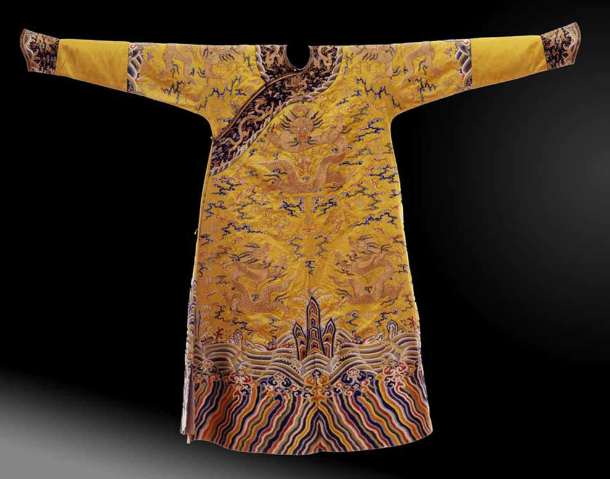Difference between revisions of "PEM E80968 Dragon robe, China (19th century)"
Jump to navigation
Jump to search
| Line 3: | Line 3: | ||
Pale yellow Chinese embroidered silk shawl. Early to mid-19th century. Imported from Guangzhou, China. Chinese crepe shawls such as this, with a ground of "bird-of-Paradise yellow" or "stem yellow" on which cordons of flowers are embroidered are mentioned in 1828 in the ''Ladies' Monthly Museum of London'' as "elegant novelties in fashion"[1]. | Pale yellow Chinese embroidered silk shawl. Early to mid-19th century. Imported from Guangzhou, China. Chinese crepe shawls such as this, with a ground of "bird-of-Paradise yellow" or "stem yellow" on which cordons of flowers are embroidered are mentioned in 1828 in the ''Ladies' Monthly Museum of London'' as "elegant novelties in fashion"[1]. | ||
| − | The Peabody Essex Museum in Salem, MA USA. | + | The Peabody Essex Museum in Salem, MA USA. E80968. |
| − | [[File:80968. | + | [[File:80968.PNG|center|frame|Image of Imperial dragon robe. ]] |
== Summary of results == | == Summary of results == | ||
| − | The major components of the plant are | + | Yellow thread from the collar seam was samples and analyzed. The major components of the plant are flavonoids: rutin, keampferol and quecetin glycosides. The dyeing source was probably [http://cameo.mfa.org/wiki/Pagoda_tree_(Styphnolobium_japonicum)_LC pagoda tree buds]. |
== HPLC profile == | == HPLC profile == | ||
| − | |||
| − | |||
| − | |||
| − | |||
| − | |||
| − | |||
| − | |||
| − | |||
| − | |||
| − | |||
| − | |||
| − | |||
| − | |||
| − | |||
| − | |||
| − | |||
| − | |||
| − | |||
| − | |||
| − | |||
| − | |||
| − | |||
| − | |||
| − | |||
| − | |||
| − | |||
== References == | == References == | ||
Revision as of 12:04, 7 August 2017
Artifact Information
Pale yellow Chinese embroidered silk shawl. Early to mid-19th century. Imported from Guangzhou, China. Chinese crepe shawls such as this, with a ground of "bird-of-Paradise yellow" or "stem yellow" on which cordons of flowers are embroidered are mentioned in 1828 in the Ladies' Monthly Museum of London as "elegant novelties in fashion"[1].
The Peabody Essex Museum in Salem, MA USA. E80968.
Summary of results
Yellow thread from the collar seam was samples and analyzed. The major components of the plant are flavonoids: rutin, keampferol and quecetin glycosides. The dyeing source was probably pagoda tree buds.
HPLC profile
References
[1] Worth, S.(1986) "Embroidered China crepe shawls: 1816-1863; Dress 12:43-54.
